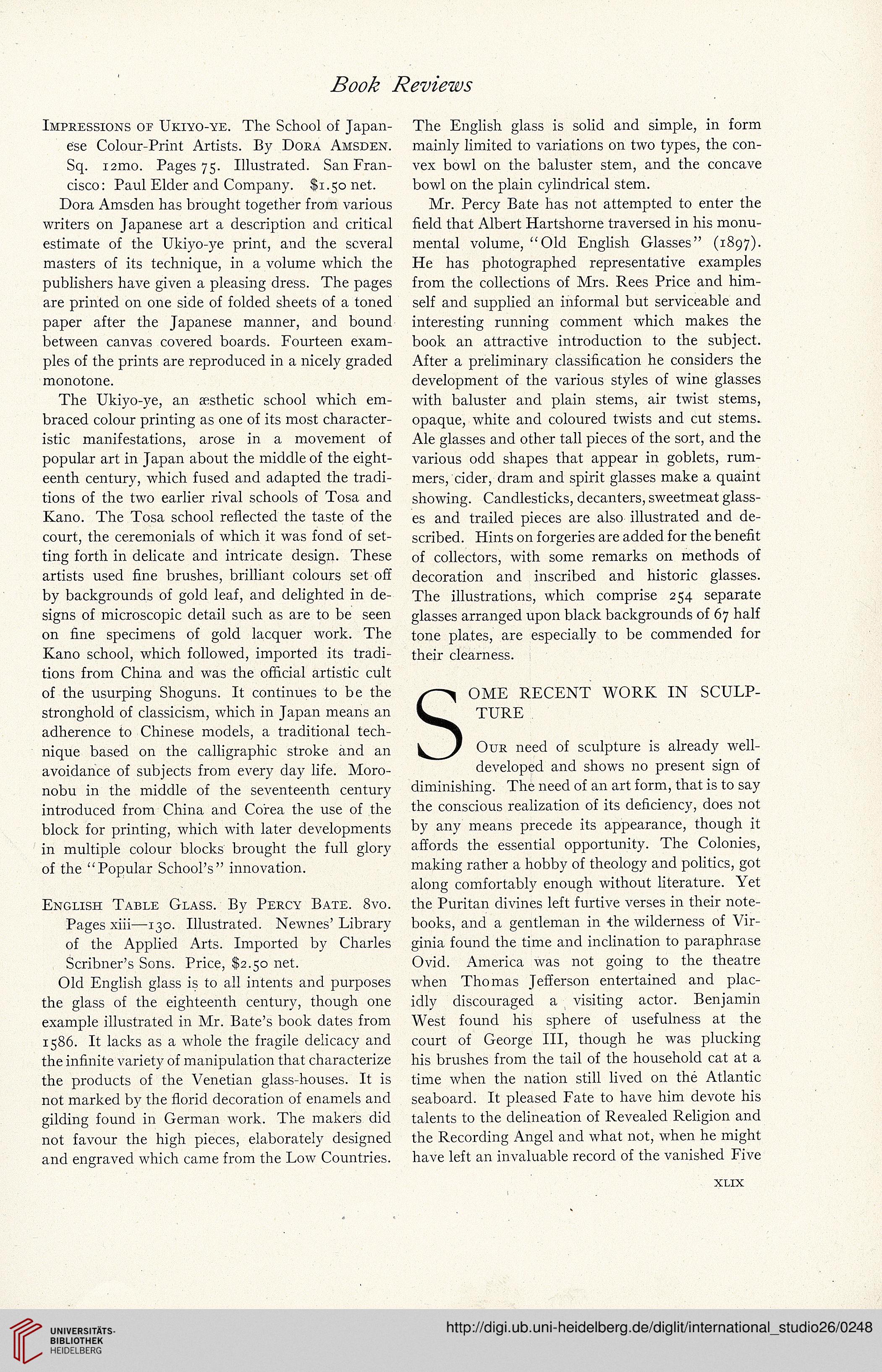IMPRESSIONS OF UKiYO-YE. The School of Japan-
ese Colour-Print Artists. By DoRA AMSDEN.
Sq. i2mo. Pages 75. Illustrated. San Fran-
cisco: Paul Elder and Company. $i.gonet.
Dora Amsden has brought together from various
writers on Japanese art a description and critical
estimate of the Ukiyo-ye print, and the several
masters of its technique, in a volume which the
publishers have given a pleasing dress. The pages
are printed on one side of folded sheets of a toned
paper after the Japanese manner, and bound
between canvas covered boards. Fourteen exam-
ples of the prints are reproduced in a nicely graded
monotone.
The Ukiyo-ye, an aesthetic school which em-
braced colour printing as one of its most character-
istic manifestations, arose in a movement of
popular art in Japan about the middle of the eight-
eenth century, which fused and adapted the tradi-
tions of the two earlier rival schools of Tosa and
Kano. The Tosa school reflected the taste of the
court, the ceremonials of which it was fond of set-
ting forth in delicate and intricate design. These
artists used fine brushes, brilliant colours set off
by backgrounds of gold leaf, and delighted in de-
signs of microscopic detail such as are to be seen
on fine specimens of gold lacquer work. The
Kano school, which followed, imported its tradi-
tions from China and was the official artistic cult
of the usurping Shoguns. It continues to be the
stronghold of classicism, which in Japan means an
adherence to Chinese models, a traditional tech-
nique based on the calligraphic stroke and an
avoidance of subjects from every day life. Moro-
nobu in the middle of the seventeenth century
introduced from China and Corea the use of the
block for printing, which with later developments
in multiple colour blocks brought the full glory
of the "Popular School's" innovation.
ENGLISH TABLE GLASS. By PERCY BATE. 8vO.
Pages xiii—130. Illustrated. Newnes' Library
of the Applied Arts. Imported by Charles
Scribner's Sons. Price, $2.30 net.
Old English glass is to all intents and purposes
the glass of the eighteenth century, though one
example illustrated in Mr. Bate's book dates from
1586. It lacks as a whole the fragile delicacy and
the infinite variety of manipulation that characterize
the products of the Venetian glass-houses. It is
not marked by the florid decoration of enamels and
gilding found in German work. The makers did
not favour the high pieces, elaborately designed
and engraved which came from the Low Countries.
The English glass is solid and simple, in form
mainly limited to variations on two types, the con-
vex bowl on the baluster stem, and the concave
bowl on the plain cylindrical stem.
Mr. Percy Bate has not attempted to enter the
field that Albert Hartshorne traversed in his monu-
mental volume, "Old English Glasses" (1897).
He has photographed representative examples
from the collections of Mrs. Rees Price and him-
self and supplied an informal but serviceable and
interesting running comment which makes the
book an attractive introduction to the subject.
After a preliminary classification he considers the
development of the various styles of wine glasses
with baluster and plain stems, air twist stems,
opaque, white and coloured twists and cut stems.
Ale glasses and other tall pieces of the sort, and the
various odd shapes that appear in goblets, rum-
mers, cider, dram and spirit glasses make a quaint
showing. Candlesticks, decanters, sweetmeat glass-
es and trailed pieces are also illustrated and de-
scribed. Hints on forgeries are added for the benefit
of collectors, with some remarks on methods of
decoration and inscribed and historic glasses.
The illustrations, which comprise 234 separate
glasses arranged upon black backgrounds of 67 half
tone plates, are especially to be commended for
their clearness.
OME RECENT WORK IN SCULP-
TURE
OuR need of sculpture is already well-
developed and shows no present sign of
diminishing. The need of an art form, that is to say
the conscious realization of its deficiency, does not
by any means precede its appearance, though it
affords the essential opportunity. The Colonies,
making rather a hobby of theology and politics, got
along comfortably enough without literature. Yet
the Puritan divines left furtive verses in their note-
books, and a gentleman in the wilderness of Vir-
ginia found the time and inclination to paraphrase
Ovid. America was not going to the theatre
when Thomas Jefferson entertained and plac-
idly discouraged a visiting actor. Benjamin
West found his sphere of usefulness at the
court of George III, though he was plucking
his brushes from the tail of the household cat at a
time when the nation still lived on the Atlantic
seaboard. It pleased Fate to have him devote his
talents to the delineation of Revealed Religion and
the Recording Angel and what not, when he might
have left an invaluable record of the vanished Five
XLIX




